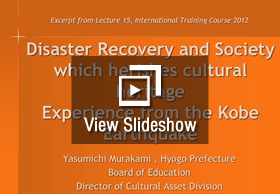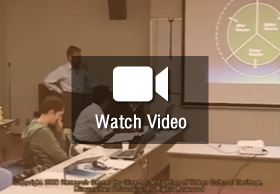

In the event of a disaster, the assessment of damage to cultural heritage is the first step towards post-disaster recovery. Damage assessment includes analysing the degree of damage to cultural heritage as a consequence of the disaster as well as analysing new risks to heritage which may have emerged as a result of disaster. The complete process involved in documenting, assessing and communicating post disaster damage to heritage needs to be explained to the participants.
Often it is not possible to undertake surveys and documentation immediately after a disaster because of lack of access, safety issues and lack of resources. Timelines need to be planned out for implementing assessment for various stages of the recovery process.
The exact procedures for carrying out damage assessment can vary. The general methodology beginning with visual surveys up until detailed documentation and analysis of physical condition of affected site or object forms part of the disaster risk management plan.
Compiling and recording of data and analysis is important not only for carrying out long term conservation but also serves as a useful resource for the site managers to update the disaster risk management plan. The collected data could potentially be needed to raise funds or generate other resources and needs to be compiled in a simple yet effective manner.
Formats for documentation and assessment of damage follow some basic principles and can be adapted to different scenarios.
The instructor may introduce the process of documenting and assessing post disaster damage, including how to plan timelines and resources for documentation, the recording and compiling methods etc. The instructor can circulate various templates and formats for documentation, recording and assessments. Through secondary examples, this lecture can be used to illustrate what kinds of information are necessary for such an exercise.
Experience of the Great Hanshin‐Awaji Earthquake: Damage Assessment, International Training Course 2011
Instructor: Yasumichi Murakami
Duration: 80 minutes
Read More...


A site visit, which may be linked to a workshop as part of a primary case study for this module, may be organised for participants to engage them in the damage assessment process.
Read More...
Workshop on Damage Assessment and Prioritisation of Recovery Workshop 5, International Training Course, 2008
Instructors: Rohit Jigyasu and Yasumichi Murakami

Site: Eskigediz Heritage Site, Turkey, R-DMUCH International Training Course 2011
Participants: Zeynep Gul Unal Meltem Vatan Kaptan
Read More...

This section focuses on the various approaches and methodologies for preventing and mitigating disaster risks to cultural heritage. This generally involves one or more of the following approaches
Key aspects to be introduced and discussed
A policy of minimal intervention should be retained as much as possible; the values, authenticity and integrity of the cultural heritage should be considered while deciding appropriate mitigation measures. Reviews should be done periodically to the disaster risk management strategy to prevent any unintended impact of risk-reduction activities.
A site visit, which may be linked to a workshop as part of a primary case study for this module, may be organised for participants to engage them in the damage assessment process. For instance, participants in 2011 International Training Course organised by R-DMUCH were given a series of lectures on the Hanshin Awaji Earthquake that was linked to a site visit the following day.

Introduction to the post disaster recovery process for cultural heritage indicating the role of assessment and right, a sample format for recording post disaster damage to cultural assets at an urban scale (Yasumichi Murakami)
Experience of the Great Hanshin‐Awaji Earthquake: Damage Assessment, International Training Course 2011
Instructor: Yasumichi Murakami | Duration: 80 minutes
This lecture used the example of the Great Hanshin Awaji Earthquake and its impact on heritage in the region. The teaching strategy for this section was twofold; with a lecture presentation highlighting a case example and a site visit/workshop that illustrated how exactly to carry out a damage assessment exercise. Participants could map out the process for their sites in the event of any potential disaster.
Background
The Great Hanshin-Awaji Earthquake was a major earthquake that struck a highly developed metropolitan city. Various types of damage to the cultural heritage had never been anticipated before, and therefore could not be addressed by the Law for the Protection of Cultural Properties.
The instructor explained the causes for extensive damage to certain types of buildings, in this case, specifically to timber buildings, especially dwellings built in the poor conditions immediately after World War II. He explained the reasons for this as the result of:
During the first week of the earthquake, any systematic survey of damage to cultural properties was impossible. The preliminary survey method that was followed to assess the damage in the earthquake was summarised as:
1. Understanding the gradation of damage from the epicenter.
2. Assessing the geographical range of the damage.
3. Interviewing locals to assess situation and extent of the damage.
4. Begin process of assessment and budgeting based on information gathered.
5. Preparation of support teams and planning out a way forward.
In the course of the assessment stage, it was found that different types of historic structures behaved differently in the earthquake. The findings were summarised, based on typology and material of heritage.

Site: Eskigediz Heritage Site, Turkey, R-DMUCH International Training Course 2011
Participants: Zeynep Gul Unal Meltem Vatan Kaptan
This case study was carried out by the participants of the International Training Course held in 2010, aimed at formulating disaster risk management plan for sites. Participants imagined a disaster scenario for their sites and developed a plan for damage assessment and post disaster recovery
Background
The historic town of Eskigediz, located in Turkey’s Kütahya Province, is highly vulnerable to earthquake. Various monuments, buildings, ruins and public squares are registered as cultural heritage. Detailed inventories of the buildings were prepared in 2003 and 2005.
Disaster Scenario Building and Response
The disaster scenario developed by the participants visualised an earthquake that led to rock fall and fires. Buildings collapsed, people were injured and there were fatalities. The electricity, communication and water supply was cut off. The roads were blocked. Panic and chaos followed.
Building Inspections
The building inspections would need to consider the risk levels before the disaster and the damaged state and usability after the disaster. The first step would be to gather qualitative data through visual inspection.
The second step would involve quantitative data through laboratory tests and numeric analysis. The damage assessment would be categorised as: safe for use (ranging from no damage to slight damage), unsafe for use (moderate to heavy damage) and dangerous for use (severe damage to total collapse).
This would be followed by post disaster recovery with short-term activities such as revising the preservation plan, cost estimation for repairs, restoring damage and the development of a rehabilitation plan. The long-term activities would include phase wise implementation of a rehabilitation plan, establishing a disaster research institute, using natural sites for health tourism and using endemic flora as economic sources. The damage would be considered through processing the data, analysing it and coming to a decision for a new conservation and restoration plan for the historic buildings and sites.


